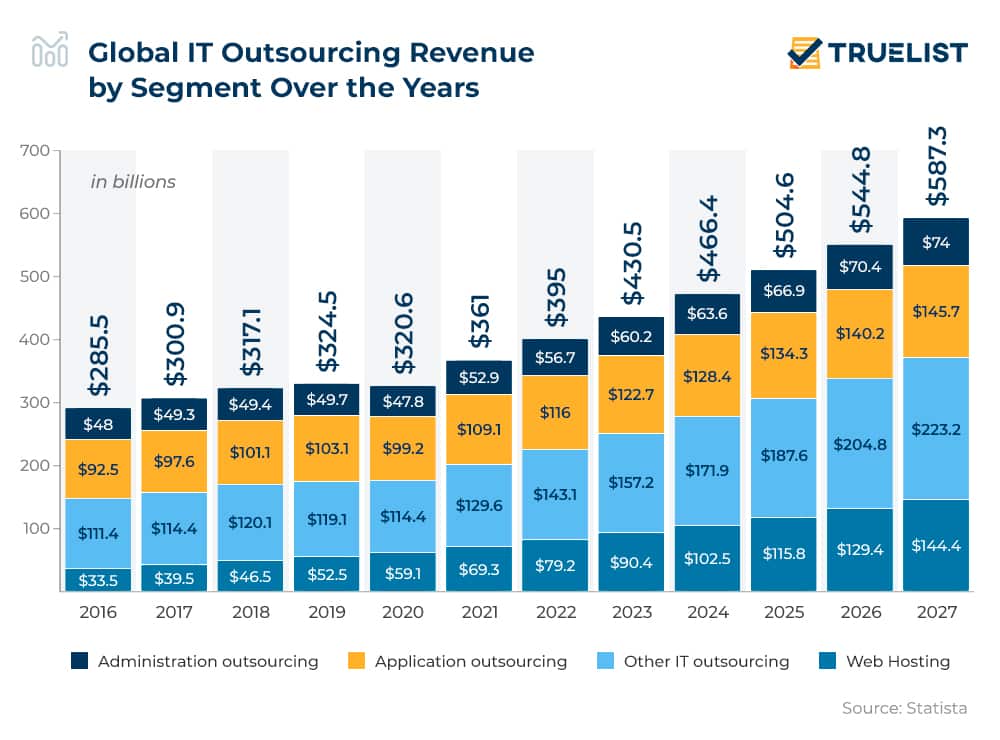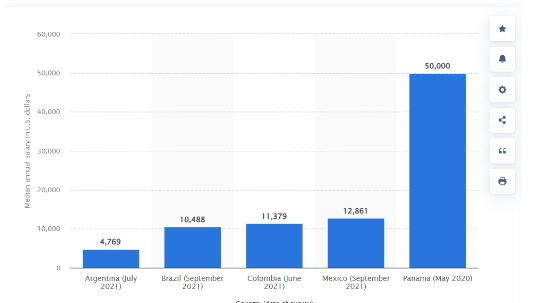Top Offshore Software Development Countries to Hire Developers
Table of Contents
With a staggering 28.7 million developers expected worldwide by the end of 2024, the talent pool is vast. Yet, finding top-notch developers without breaking the bank is a challenge many in the tech world face. This is where offshore software development steps in.

https://truelist.co/blog/outsourcing-statistics/
Outsourcing software development is on the rise, with the global market projected to reach a whopping $937.67 billion by 2027. And it’s easy to see why—it’s a solution for industries hungry for software development but lacking the in-house expertise or resources to handle it themselves. This is why you should look into different hiring options and best offshore software development countries.
So, where does one begin when considering offshore options? Well, the best offshore software development countries are like hidden treasures. They offer access to a wide talent pool, enabling quicker project completion at a fraction of the cost.
But here’s the catch: offshore software development isn’t a one-size-fits-all solution. It varies widely across regions, countries, and niches. Navigating through these options can feel like trying to find your way through a maze blindfolded.
So, what’s the secret sauce to finding the right offshore partner? From my observation, it boils down to real-world experience. Successful offshoring isn’t just about saving money—it’s about adding value at every stage of the development process.
By partnering with the right region and the right team, one can achieve a perfect blend of quality, cost-effectiveness, and speed, giving projects the boost they need to thrive in today’s competitive market.
1. Why Should You Consider Offshoring Software Development Projects in the First Place?
Ever wondered why bother outsourcing software development projects, even though it can save you time, and money, and bring in top-notch expertise? Well, think about it like this: outsourcing isn’t just about cutting costs or finding talent—it’s about unlocking a world of possibilities for your business. It’s like having access to a global talent marketplace where you can handpick the perfect team for your project, no matter where they are in the world and choose the best offshore software development countries to offshore developers.
Plus, let’s not forget about the time and energy you’ll save by outsourcing tasks that may not be your core competency. Instead of getting bogged down in the nitty-gritty of software development, you can focus on what you do best—growing your business and serving your customers.
But here’s the kicker: outsourcing isn’t without its concerns. You might worry about things like political instability in certain regions or language barriers hindering communication. And yeah, those are valid concerns.
We have listed the pros and cons of offshoring;
Pros:
- Access to top-notch global talent: Outsourcing opens doors to a vast talent pool of well-educated and highly skilled professionals from around the world. This means you can handpick the best-fit experts for your project, regardless of geographical boundaries.
- Cost savings: One of the most appealing aspects of outsourcing is its potential to significantly reduce costs. By outsourcing, you can tap into regions where labor costs are lower, saving you up to 30% compared to hiring in-house teams or local contractors. This frees up your budget for other crucial aspects of your business.
- Risk management: Outsourcing enables you to partition software development tasks among multiple vendors or teams, spreading out the risk. This diversification can safeguard your project against unexpected challenges or setbacks, ensuring smoother operations and project continuity.
- Flexibility in hiring: Unlike traditional hiring models that require you to maintain a full-time staff year-round, outsourcing offers flexibility. You can scale your team up or down as needed, hiring talent for specific projects or durations. This agile approach allows you to adapt to changing project requirements and market demands without the burden of long-term commitments.
Cons:
- Political and economic instability: While outsourcing can offer cost savings and access to global talent, it also comes with risks, particularly in regions prone to political or economic volatility. Sudden changes in government policies, regulations, or economic conditions can disrupt business operations and impact project timelines. It’s essential to conduct thorough risk assessments and choose outsourcing destinations wisely.
- Language barriers: Communication is key to successful collaboration, but language barriers can pose challenges when outsourcing to non-English-speaking countries. Misunderstandings, miscommunications, and cultural differences may arise, potentially impacting project clarity, efficiency, and outcomes. Effective communication strategies, including clear documentation and regular updates, are essential to bridge language gaps and ensure project success.
- Time zone differences: Collaboration across different time zones can introduce logistical hurdles and communication delays, affecting project coordination and responsiveness. Scheduling meetings, resolving issues in real-time, and maintaining seamless communication may require extra effort and flexibility from both parties. Adopting tools and practices that facilitate asynchronous communication and workflow management can help mitigate the impact of time zone differences and foster effective collaboration.
2. Best Countries to Offshore Software Teams Based on Regions in the Globe
- Asia:

If you are looking for a powerhouse in software development, Asia’s the place to be, and India leads the pack. With over 6 million skilled IT professionals, India offers quality solutions at competitive prices. It’s a top destination for anyone seeking top-notch software development services without breaking the bank.
- Europe:
Over in Europe, Ukraine shines as a top contender for software outsourcing. Boasting around 300,000 highly skilled developers, Ukraine offers competitive pricing and a strong focus on technical education. Its thriving IT sector makes it a prime choice for those considering software development in Eastern Europe.
- Latin America:
Latin America is making waves in the software development scene, and Mexico is leading the charge. With its close proximity to the United States and a booming IT industry, Mexico is a top pick for offshore software development in the region. As of 2021, the country boasted a whopping 700,000 tech specialists, making it a promising destination for quality software solutions.
Each region brings its own unique strengths to the table, providing ample opportunities for businesses looking to leverage offshore software development for their projects.
3. Offshoring in Europe
European developers have honed skills in a bunch of areas like the Internet of Things (IoT), Artificial Intelligence (AI), Machine Learning (ML), and Augmented and Virtual Reality developers stand out because they not only provide high-quality services but also offer them at affordable rates.
European developers stand out because they not only provide high-quality services but also offer them at affordable rates at many locations. Here is a salary breakdown of European developers;
Overview of Developer Salaries in Europe (talentup.io)
#Poland
Poland’s tech scene is booming, making it a hot spot for software development. With over 250,000 developers and more than 1,100 companies in the game, there’s no shortage of talent here. Plus, the industry is growing like crazy, with predictions of hitting over 3 billion bucks by 2023. And let’s talk language – Polish developers are ace in English, German, French, and Spanish, so communication is a breeze.
#Romania
Romania’s tech scene is on the rise, and software development is leading the charge. With predictions of a whopping 12% GDP growth by 2025, it’s clear that this industry means serious business. As an EU member, Romania is a major player in the offshore market, especially when it comes to outsourcing services to the US, Canada, and Europe.
#Ukraine
Ukraine shines as a top global destination for software development outsourcing, bolstered by government support and a conducive business environment. With over 349,000 skilled developers and around 5,000 companies, the market is robust and growing at a rapid pace of approximately 25% annually. Ukrainian engineers, equipped with university degrees and English proficiency, ensure effective communication and high-quality work. Dominant programming languages include React, JavaScript, Java, Python, PHP, Swift, and AWS, catering to diverse development needs spanning distributed systems, security, FinTech, eCommerce, and Enterprise solutions.
4. Offshoring in Latin America: Best Country in Latin America for Software Team Offshore Hiring
Software developers salaries Latin America 2021 | Statista
In Latin America, software developers are increasingly sought after for their expertise and cost-effectiveness in outsourcing endeavors. According to Statista, Panama stands out with the highest median annual salary among developers in the region, reaching $50,000 USD. This reflects a growing recognition of the quality of talent in the country. Outsourcing software development to Latin America offers businesses the advantage of accessing skilled professionals at competitive rates while fostering cultural proximity and streamlined communication, making it an attractive option for companies worldwide seeking reliable tech solutions.
#Brazil
Brazil, the giant of South America, is making waves on the global stage, especially in the tech world. With over 6,000 software companies and a software market valued at a whopping $11.3 billion, it’s clear that Brazil means business. And when it comes to software development and offshoring talent, Brazilian experts shine in Java and .Net, making them hot commodities for companies worldwide.
What’s more fascinating is that Brazil’s time zones sync up nicely with the US, for being a Latin American country, so collaborating with Brazilian teams is a breeze during regular business hours. Plus, their culture is pretty compatible with Western norms, though they do stand out with Portuguese as the main language, unlike the rest of Latin America where Spanish is the main language.
And let’s talk talent – Brazil churns out over 200,000 STEM grads every year, ready to take on the tech world. Cities like Sao Paulo, Rio de Janeiro, and Belo Horizonte are buzzing with tech innovation, making them hotspots for startups and big tech players alike.
#Argentina
Argentina is booming with innovation and entrepreneurship, with a dynamic startup scene that’s alive and kicking. Boasting a hefty GDP of nearly $500 billion, Argentina stands tall as one of the big players in Latin America’s economy.
Education? You bet! With a highly educated workforce, Argentina proudly sits at 34th place in global education rankings. And when it comes to software development, Argentina doesn’t mess around. Known for churning out top-notch software pros, they’ve built a solid reputation for quality. By 2026, revenues in this industry are set to soar to over $2.7 billion – not too shabby!
But it’s not just about the numbers. Argentina is home to some major tech hitters like MercadoLibre and Despegar, making their mark on the global stage. And let’s not forget about the support system – with business incubators and accelerators aplenty, entrepreneurs here get the resources and backing they need to thrive. Take Aceleradoras BA Emprende, for example – this Buenos Aires initiative has pumped over $3.5 million into local ventures, fueling growth and innovation in the tech scene.
#Mexico
Mexico is a force to be reckoned with in the tech world, boasting a whopping 225,000 developers who are making waves in the industry. This impressive talent pool speaks volumes about Mexico’s dedication to nurturing tech expertise. And get this – by 2023, the country’s software industry revenue is set to skyrocket to a jaw-dropping $3.9 billion, highlighting its rapid growth and influence in the tech sector.
Mexico is not just keeping up; it’s leading the charge in tech innovation. With over 20 tech parks, including big names like the Creative Digital City and Guadalajara Software Center, Mexico is at the forefront of cutting-edge technology. And talk about startup fever – in 2022 alone, Mexico saw the birth of 453 new startups, with even more on the horizon for 2023.
And here’s the kicker: the Mexican government is doubling down on tech education by opening 120 tuition-free tech universities. This bold move is ensuring a steady stream of skilled professionals entering the workforce. With over 130,000 engineers graduating every year, Mexico’s status as a tech powerhouse is only getting stronger. Watch out world, Mexico means business in the tech game!
#Uruguay
Uruguay might be small in size, but it’s making big waves in the software outsourcing scene. With over 1,000 software development companies raking in nearly $1 billion in exports annually, mostly to the US, it’s clear that Uruguay plays a major role as a Latin America country in software business.
Uruguay’s got a solid education system focused on software development, churning out a highly educated workforce ready to tackle tech challenges. Plus, the business vibe here? Totally friendly and welcoming. In terms of tech cred, Uruguay doesn’t disappoint. They’re second to none in Latin America when it comes to digital readiness, thanks to their top-notch tech infrastructure and investments from both businesses and governments.
#Colombia
Colombia is another LatAm country stepping up its game in the tech world, backed by a solid network of universities, research institutions, and a government that’s all in for supporting software outsourcing. The Ministry of Information and Communication Technologies (MinTiC) is on a mission to tackle a looming talent shortage by rolling out initiatives to grow the tech workforce and attract more bright minds to the industry. With projections showing a potential shortage of over 100,000 developers by 2025, these efforts are crucial.
Now, while Spanish is the go-to language for Colombians, English is also official in spots like the Andrés, Providencia, and Santa Catalina Islands – handy for global communication.
Colombia is ranking high in the outsourcing and IT markets, after big players like Brazil. With homegrown success stories like MercadoLibre and Acelero leading the charge, Colombia is proving its tech prowess on a global scale.
5. Criteria for Evaluating Offshore Software Development Countries
When considering where to offshore software development teams, it’s vital to take a good look at the various factors in play. Think about things like the talent pool available, how well they match your needs, and whether they’re easy to work with culturally. The cost is a big factor too! Each country you might consider has its own perks and challenges, so it’s worth digging deep to find the best fit for your project. By doing your homework on these criteria, you can find the perfect match for your software development needs and set yourself up for a successful partnership. Here, we have mentioned some of the major criteria for evaluating offshore software development countries.
- Experience: Developers are selected based on their experience in software development and specific industry knowledge, ensuring they understand the project’s unique challenges and requirements.
- Technology Proficiency: The skills and expertise of developers are assessed in relevant technologies, frameworks, and programming languages, ensuring they are proficient in handling complex tasks.
- Development Cost Considerations: While cost is important, it isn’t the only factor considered. Pricing models, cost structures, and overall affordability are evaluated in relation to the quality of work and services provided.
- Flexibility and Scalability: The ability of developers to adapt to changes in requirements and provide scalability options is assessed, ensuring they can accommodate the project’s evolving needs.
- Commitment and Reliability: Developers are chosen based on their commitment to meeting deadlines, delivering high-quality work, and maintaining transparent communication throughout the project, building trust and fostering successful partnerships.
- Time Management and Development Process: The project management methodologies of developers, their ability to track progress, and adherence to timelines are discussed, ensuring efficient project execution and delivery.
- Effective Communication: Emphasis is placed on clear and proactive communication. Developers who provide regular updates, are responsive to queries and feedback, and maintain transparent communication are preferred.
- Legal Considerations and Avoiding Lock-In Situations: Clarity on ownership rights, intellectual property protection, and contractual obligations is ensured. Exit strategies are discussed to avoid potential lock-in situations, with legal agreements protecting the interests of both parties.
6. Common Offshore Software Development Challenges
Offshore development promises cost savings, but it often comes with unexpected challenges that can hit hard when it’s too late. Still, many are diving in. Deloitte’s recent survey found that 65% of respondents are gearing up to build offshore teams, especially in areas like big data, enterprise mobility, and cloud computing. The big draw? Price. Offshore developers offer lower hourly rates compared to their U.S. counterparts, be it teams or freelancers. Just think about it: U.S. staffing agencies demand hefty upfront fees, usually a hefty 25% to 50% of the project cost. That’s a hefty price tag to swallow, especially when you’re still nailing down project details and timelines.
-
Cost Saving
When companies opt for cheaper, less experienced developers, they often find themselves losing out financially. While the hourly rate might seem like a steal, it’s often overshadowed by the extra hours needed to fix mistakes and overcome skill gaps. This translates to lower productivity and a lot more time spent debugging throughout the project. It’s basically Brook’s Law in action: adding more developers to the mix ends up slowing things down rather than speeding them up.
-
Managing Code Quality
When you’re collaborating with a team you’re not familiar with, keeping tabs on quality can be a real challenge. Offshore developers often have different approaches to business practices and project management, which can lead to misunderstandings. This disconnect can sometimes mean the end product falls short of what you were hoping for. Plus, you might find yourself partnered with fresh IT graduates or developers who are still finding their feet. That’s why the development community emphasizes the importance of best practices, but unfortunately, not every offshore team follows suit.
-
Language Barrier
When language and cultural barriers come into play, it’s no surprise that offshore development teams can struggle to grasp requirements or align with overall business strategies, often resulting in more errors. Working in different languages makes it tricky to communicate nuanced or niche needs, and understanding development challenges becomes a real hurdle. However, many developers in Latin America are proficient in English. Cultural differences can further complicate matters, as varying expectations and communication styles may lead to misunderstandings and project delays.
-
Managing Logistics
Managing an offshore development team involves a complex juggling act of coordinating deadlines, meetings, calls, and aligning work expectations to ensure everyone stays on track. Factor in the significant time zone differences, often leading to inconvenient middle-of-the-night meetings, and you’re looking at extended turnaround times. These logistical challenges, along with others, can quickly escalate into serious frustrations, causing budget overruns, timeline delays, and scope creep.
7. How CloudDevs Can Help You To Hire Offshore Developers?
CloudDevs is your go-to platform for finding top-notch remote senior developers and designers. With over 8000 carefully vetted talents mainly from Latin America, we ensure they’re in sync with global project needs across various time zones.
Here’s what CloudDevs bring to the table: lightning-fast talent assignment within 24 hours, teams aligned with your time zone, transparent pricing, a risk-free 7-day trial, and flexible rolling weekly contracts with no long-term commitments. Plus, hiring offshore developers through CloudDevs can slash your hiring costs by 50% – 60% compared to local hires in the US. CloudDevs experienced talents, boasting an average of 7+ years in senior-level roles, have delivered for top organizations worldwide. This is why you should consider hiring offshore developers from CloudDevs.
8. Conclusion
Offshoring developers is a great strategy, but choosing the right destination to offshore isnt always easy. Offshoring software developers from Latin America offers a strategic advantage for businesses seeking top-tier talent at competitive rates. With a rich pool of skilled professionals, aligned time zones, and cost-effective solutions, the region emerges as a prime destination for outsourcing tech projects. Leveraging platforms like CloudDevs can further streamline the process, providing access to pre-screened talents and flexible hiring options. As companies increasingly embrace remote work and global collaboration, tapping into Latin America’s vibrant tech ecosystem presents a promising path to innovation and success in the digital age.












